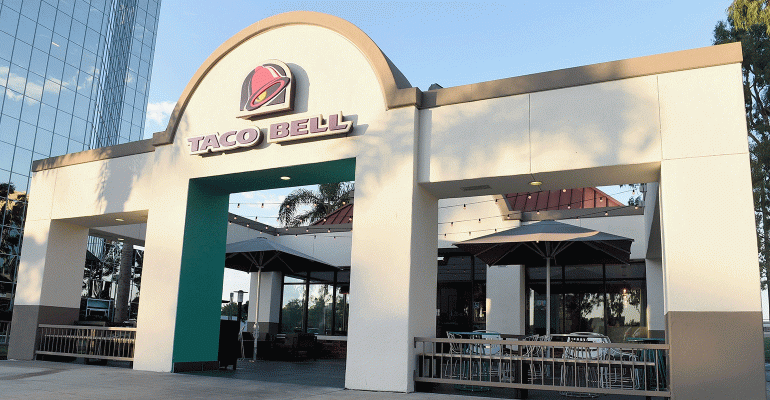Despite a tortilla shortage at Taco Bell, the Irvine, Calif.-based chain set two weekly sales records during its latest quarter thanks to the return of Nacho Fries and several popular value items.
Taco Bell, along with KFC, contributed to sales gains at parent company Yum! Brands Inc., which reported a 5% growth in global same-store sales.
Still, Yum CEO Greg Creed was not pleased by the supplier issue Taco Bell faced in early July. He said the regional shortage of 10-inch flour tortillas lasted about nine days and impacted sales.
Running out of supplies used for core menu items such as burritos and quesadillas was “clearly unacceptable,” he said.However, Creed noted that the loss in sales did not have a “material” impact on the brand.
“Have we taken it up with our supplier? Yes. But I think the key take away is, it had an impact, but we don't believe it was a material impact and our objective is to make sure we don't obviously run out of core menu items going forward,” he said.
Taco Bell, which named a new CEO last week, reported a 7% increase in same-store sales for the quarter.
Gains were driven by value promotions such as the $1 loaded Nacho Taco and the $5 Grande Nacho Box. The return of Nacho Fries during the quarter also contributed to sales.
During the quarter, six million more cars drove through Taco Bell drive-thrus compared to the same quarter last year, Gibbs said. Throughput in the drive thru has improved to an “average seven seconds faster,” Gibbs said.
“This attention to improve speed, customer satisfaction and running great restaurants helped the Taco Bell system break two weekly sales records just one week apart,” Gibbs said.
Though it had no impact on sales, Creed said the most “buzzworthy moment” of the quarter for Taco Bell was the announcement of The Bell: A Taco Bell Hotel and Resort.
The brand is taking over a Palm Springs, Calif. hotel and infusing it with Taco Bell branding for four nights starting Aug. 8. Reservations sold out in two minutes.
Creed said events like these are important differentiators for the brand.
“The innovation is really spot on. They're doing great cultural icon things like the hotel,” Creed said. I've probably had more customer complaints about they couldn't get a room at the hotel than I've had on anything on Taco Bell in the last five years. The brand is in great shape and doing the right things.”
Pizza Hut to close stores
Though it recorded same-store sales gains for the quarter, Pizza Hut remains Yum’s weakest division. As such, the company said it is moving forward with a plan to downsize domestic dine-in locations by as much as 500 restaurants over the next two years.
“The short-term financial impact should be minimal as the closures will be our lower volume stores,” Gibbs said.
Gibbs said the Plano, Texas-based chain has 7,448 U.S. restaurants. Of those, 6,100 are traditional restaurants and about 1,350 are express units. The plan is to replace the traditional locations with express stores.
But the new openings won’t happen overnight, which is why Pizza Hut’s overall U.S. units could drop as low as 7,000 locations, Gibbs said.
“It’s hard to estimate how soon the timing of one store will close and when the replaced unit will open,” he told analysts. Analyst Mark Kalinowski said Pizza Hut’s transition away from its sit-down heritage business is a solid move.
“We believe that this is the proper move to make strategically,” said Kalinowski of Kalinowski Equity Research.
The closures comes as Pizza Hut has made efforts to revitalize the brand through value promotions, a new retro logo and growth of its carryout business.
Last week, the chain said it was testing a 12-compartment digitally powered pick-up system that allows consumers to order ahead and fetch their pizzas from a cubby without interacting with an employee.
Creed said Pizza Hut also plans to expand its delivery test with Grubhub, which is currently available at 300 restaurants. Orders come through the Grubhub marketplace, but Pizza Hut drivers make the delivery.
“While still early days, we found that the Grubhub customers are incremental and some customers are therefore trying our craveable products for the first time,” Creed said. “The way to grow business is to increase reach and penetration.”
Pizza Hut’s same-store sales for the quarter grew 2%.
Louisville, Ky.-based Yum said KFC was a major contributor to the company’s overall gains for the second quarter ended June 30.
The chain, also based in Louisville, reported 6% growth in same-store sales. Globally, the company saw strong gains in Japan, Africa, Iberia, Indonesia, Germany, Australia, China, Latin America and the Caribbean.
“This global powerhouse is seeing broad-based strength across the world with standout performances across many of our largest markets,” Creed said.
In the U.S., same-store sales increased by 2% and was driven by new menu items such as Chicken & Waffles and Cinnabon Biscuits. A 2 for $6 Mix 'n Match deal also contributed to sales and transaction growth.
Yum reported total revenue of $1.31 billion, compared to $1.37 billion for the same quarter, last year. Net income of $289 million, or 92 cents per share, compared to $321 million, or 97 cents per share, for the same quarter, last year.
Contact Nancy Luna at [email protected]
Follow her on Twitter: @fastfoodmaven




